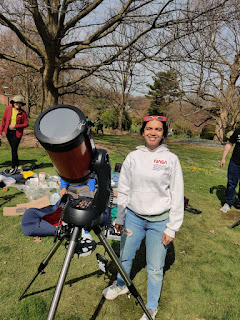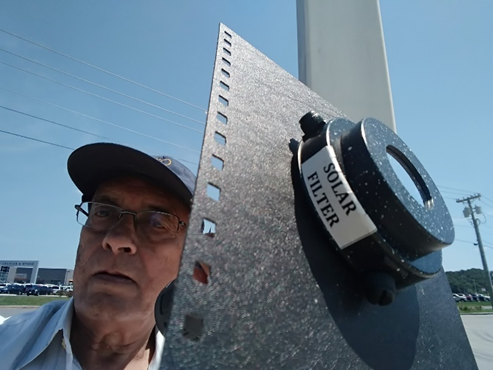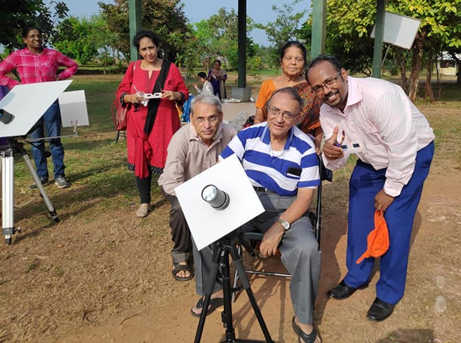The Great
North American Eclipse of 08Apr24
A tale of two
sightings
“In
rating natural wonders, on a scale of 1 to 10, a total eclipse of the Sun is a
million.”
-
Fred Espenak
Progression
of eclipse as captured with a small telescope at Mansfield, Ohio, USA
This is an account of the agony
and the ecstasy associated with a successful chase of the Great North American
total solar eclipse of 08 April 24 at two different locations in the USA by two
Indian amateur astronomers who made their personal journeys from far off Mysore,
India.
[For
a detailed curtain raiser to this event, please see my last blog article here. For my other articles on total/annular solar eclipses, see 1,
2 ,3,
4
and 5.]
Anticipation
Ever since I saw the total solar
eclipse of 21Aug17 at Clarkesville near Nashville, Tn, in the USA, the one to
follow this year in the same country was on my radar constantly. I started planning for it after watching a
spectacular annular solar eclipse in my own country on 26Jan19 along
with my longtime associate and amateur astronomer Mr Krishnamurthy Mudugodu (Murthy
for short) and others at Bekal Beach on coastal Kerala. Though Murthy’s
interest was equally aroused, he saw a firm opportunity for viewing the Great
North American Eclipse only recently.
Our plans turned out to be intentionally
divergent – mine to settle for a location in southern Texas, and his for a northeasterly
location, in Ohio state. After reviewing
logistic and climatic factors, we settled on Waco, Texas, and Mansfield, Ohio
respectively, hoping that both, or at least one of us, would end up lucky enough
to view the much-anticipated event at a time of the year when weather and cloud
coverage were rather highly unpredictable.
Expectation
Detailed interactive maps of this and
other eclipses are readily available on several websites. Particularly useful was this website where,
apart from information in meticulous detail, the expected progression of the
eclipse could also be simulated for any given location. The predicted eclipse parameters for Waco, Tx
and Mansfield, Ohio are shown in the maps below:
Preparation
Considering that I had to travel half way round the world from home, I laid aside all thoughts of carrying any of my telescopes and accessory equipment for a non-amateur style observation and recording of the event. Instead, I settled for simple hand-held equipment, such as a pair of binoculars fitted with a solar filter for visual observation, and a 25x zoom Panasonic Lumix camera, also fitted with a similar filter for basic photography (see picture below). Even here, I opted for a light-weight 8x40 Cason binoculars instead of my preferred 7x50 Olympus binoculars, and desisted the temptation to carry a massive 125x Nikon Coolpix P1000 Camera.
Weather Outlook
We started looking up weather
predictions for eclipse day at the two locations at least a fortnight in
advance; they were definitely not encouraging. About a week before, there were
no significant changes. Three or four days before, the outlook turned
distinctly hostile, with both rain and extensive cloud coverage forecast over
Waco at least, about an hour on either side of totality, which was around 1:35
pm local time. For me, visions of a bygone experience in distant China way back
in 22 July 2009 started taking shape (see here). There was nothing I could do but mark time
with increasing unease. Murthy’s experience couldn’t have been any less
agonizing. He was beset with even greater
uncertainty since he was to decide on a location only just a few days ahead.
Journey
I reached Houston from Bangalore on 5th
April and proceeded to Austin Tx two days later after touring the Johnson
Space Center which had been heavily waterlogged during my last visit to the USA. I then made it to Waco, Tx by bus on the
eventful day. I had settled for the open
grounds adjacent to the McLane Football Stadium as the venue, where public
viewing had been organized by the Baylor University authorities. My travel itinerary was inflexible, and I had
really no plan B if Waco had proved untenable. I had considered Hillsboro as an
option, but gave up the idea when I found its weather pattern was not much
different from Waco.
Based in Durham, North Carolina, Murthy
started his long road journey with his family on 5th April, with halts at Blacksburg
and Johnstown near Columbus on the way, joined by friends at both places. Before
proceeding to the eventual venue at Mansfield, he had time for an elaborate rehearsal
of the sequence of activities that were to unfold on the eventful day. He also had ample time to soak in the
beautiful unpolluted night sky and take delight in locating familiar objects,
but at a higher latitude (40o N) than he was accustomed to at home
(12o.5 N). His itinerary was somewhat flexible, with Springfield as
an alternate venue. He dropped the idea
when he realized that the duration of totality there was almost a minute less,
and the extra minute at Mansfield was, in his own words, ‘worth its weight in
gold’. They reached the beautiful Kingwood Gardens in Mansfield early morning and
began their long day’s activities amidst picturesque surroundings.
Weather
When I left Austin by an early morning bus for Waco on eclipse day, one look at the skies and my worst fears threatened to come true. It was as dark and overcast as I had seen anywhere for a long time. The best that happened by the time I reached the bus station at Waco was a distinctly clear silver shading to the dark clouds. Buoyed up by this discovery, I leisurely walked up for about an hour to the great big football stadium whose backyards were being thrown open for public viewing, at a price. After a long wait due to bureaucratic delays, I finally entered the ‘reserved’ space around the stadium a part of which can be seen in the picture below around noontime when the sky had begun to undergo a remarkable transformation.
Partial phase
The 80-minute-long partial phase of
the Great North American Eclipse had begun and my excitement began to grow with
every bite of the mighty Sun the puny Moon had eaten away relentlessly. Here is a sequence of this phase I captured
with my Lumix camera, set at full 25x optical zoom and auto-focus:
For the most part of the partial
phase, clouds were playing hide and seek with the Sun, without blotting it out
altogether.
Murthy’s sequence of superior quality
pictures taken with his small refractor telescope are displayed as a composite
visual at the beginning of this article.
Totality at Waco!
As the Sun’s disk was being gobbled
up by a rapidly advancing moon, there was a noticeable drop in both brightness
and temperature of the surroundings, and this was a welcome relief too from the
harsh Sun.
As beginning of totality (second
contact) approached, everything around us started dimming, the temperature
dropped noticeably and produced a soothing effect, the heightened excitement
was palpable, and it gave way to indescribable amazement at the sight of a
spectacular diamond ring in a flash, which disappeared almost instantaneously
to reveal the fabled solar corona which is visible only on such an occasion. To
my surprise the corona looked like a small symmetrical ring around the
Sun, and indeed some viewers close to me remarked that it was the ring of
fire. Of course, it could not be, because
we were watching a total eclipse, not an annular one that could also be seen in
that part of the world on 23rd October last year. Perhaps it is no wonder that it appeared like
a ring of fire because the now totally cloudless sky around the Sun could still
be seen faintly. It was far from the level
of darkness normally expected. I will
not go into plausible reasons why this was so.
However, as a visual spectacle, it was a bit of a letdown. Consequently,
the star field surrounding the Sun was barely visible, and I had a hard time identifying
even the planets Venus and Jupiter. (Also, I could not identify the Bailey’s
beads just before the diamond ring effect)
As planned, I refrained from trying
out any photography during this 4+ minutes of precious time when one’s vision
has to be firmly planted on the corona and its neighborhood. As planned before, I started looking through
my binoculars after removing the filter covering it.
Below is the only picture I took
during totality, with my OnePlus Open smartphone, unedited. It does appear to
be overexposed, but still the level of brightness around the Sun is
surprisingly high. I have no cogent explanation for it at this time.
Below are two pictures, one showing my surroundings sometime during the totality phase and the other a short while after the end of totality. The level of brightness during totality is much higher than I expected:
I was in constant touch with Murthy before, during and after the event, which was his first experience with a total solar eclipse. He went to the venue with meticulous preparation, took some fine pictures without compromising on the visual observations, and led a team of both enthusiasts and serious observers on an exciting mission. The picture below apparently shows all the members of his team at the lush green Kingwood Gardens in Mansfield, a far more picturesque place than the one I visited.
The
Mansfield, Ohio Group
Back Row (l to r): Meenakshi Krishnamurthy, Aishwarya Nair, Krishnamurthy
Mudugodu, Harshavardhan Chaturvedi and Brian Henning
Front Row: Maithri Krishnamurthy and Shreyas S Bhat
Here is a picture of the Mansfield group deploying all their ware and getting down to business. This is when the staff employed at the garden center mistook them for an eclipse filming crew!
Below is a map of the exact location at which the group set up their day long vigil:
Here is a picture of Murthy with some of his equipment:
The picture below depicts the right way to observe any astronomical phenomenon, but viewing the solar eclipse on a hot afternoon may not have been a comfortable experience!
Below is a summary of Murthy’s key observations
conveyed to me both orally and in writing
· The weather
was better than in Waco even early in the morning, and kept improving as the
day progressed. Though there was a haze
much of the time, the observations were not significantly affected.
· One of the
group’s pictures of the partial phase taken with a Celestron NexStar 8SE
telescope shows three tight groups of sunspots (see picture below)
· The 8SE telescope can itself be seen in the picture below with its proud owner:
·
Murthy was able to see the diamond ring effect at
third contact, but not at the second.
Here is a picture of it taken with a Sony Alpha A7III mirrorless camera
with 7300 mm focal length lens system:
· A careful look at the picture below reveals a row of Bailey’s beads just before the diamond ring effect. This picture was taken with the same camera as above.
· Here is a view of the solar corona captured near the midpoint of totality. A more asymmetric and spikier corona was expected since the eclipse is happening near the 11-year peak of solar activity. At this point in time, I have no idea why this was not realized.
·
The video clip below, shot at Kingwood Gardens in
Mansfield during totality, clearly shows darker surroundings* all around than
the ones I saw in Waco. This explains why Murthy could see both Venus and
Jupiter, and I missed them. Unfortunately, he seems to have missed out on
trying to capture the view/s with his smartphone amidst all the excitement. So
did I!
[*Murthy
describes the darkness he saw as similar to the one after sunset.]
Murthy’s final summation:
It was
wonderful to experience the gradual decrease in brightness and temperature of
the surrounding environment as the totality approached and progressed. There
was an eerie silence which immediately turned into a collective gasp of
exuberance as the totality began. At this moment we opened all the solar filter
caps to capture the totally eclipsed sun on camera. We also
took a step back to soak in the moment and directly see the
eclipsed sun. Experiencing the spectacular beauty of the total solar eclipse live
is something that is hard to express in words.
In the
meantime, during the partial eclipse stage a few curious onlookers approached
us to see what we were doing, and were enthralled to see the eclipsed sun through
various different lenses. The solar filter-capped binoculars were a definite
crowd favorite!
In conclusion,
it was certainly a memorable experience of a phenomenon of nature which rarely
repeats in a particular place. We were one of the early arrivers and the last
to leave. We were lucky to have clear sky in spite of partly cloudy weather
forecast.
Appendix
[ I had sent the following note to the prospective
followers of my blog on the day after I viewed the eclipse]
Here is some
news about the great North American Total Solar Eclipse of yesterday (8Apr24)
that I observed successfully from Waco, Texas. It was the seventh time in a row
that luck favored me with total/annular solar eclipses. In this context, my
last blog article may be relevant. The next article will describe how
Krishnamurthy and I were able to explore the event of yesterday from two very
different locations in the USA. At Waco,
the sky was totally overcast and made it virtually hopeless for a visible
event, but the weather made a miraculous turnaround as the day progressed. The
partial phase could be seen playing hide and seek with the clouds, but as
totality approached, there were no clouds anywhere near the Sun! I would like
to flatter myself that it happened because of my presence at Waco!? Please do
look forward to my next blog article, about this event, after my present
long trip abroad.
Fast Forward
While Murthy
and I are both basking in the glory of the Great North American Eclipse of last
month, my sight is fleetingly set on Valencia, Spain for the next total solar
eclipse that will last barely a minute, on 12th August 2026! But,
the one to follow a year later on 02 Aug 27 at Luxor, Egypt, lasting a whopping
6 min, 23 sec, would be, to borrow a description from Murthy and twist it appropriately,
‘worth its wait (wait, this is not a spelling mistake!) in gold!’ I hope
he and others, especially our mutual friend Ilavenil, who was denied the
opportunity to see both the last two great American eclipses, can join
me in these adventures.
Tailpiece
Just two days
after I saw the eclipse at Waco, I had the immense satisfaction of visiting Chichen
Itza, a complex of fabulous Mayan relics near Cancun in Mexico, rated one
of the seven wonders of the world. This
also meant that I had seen all the seven wonders, adding to my collection of
seven total/annular solar eclipses spanning equally diverse locations on the
globe. My next blog article will address
this aspect of my adventures, so appropriately suggested by one of my
acquaintances.






























